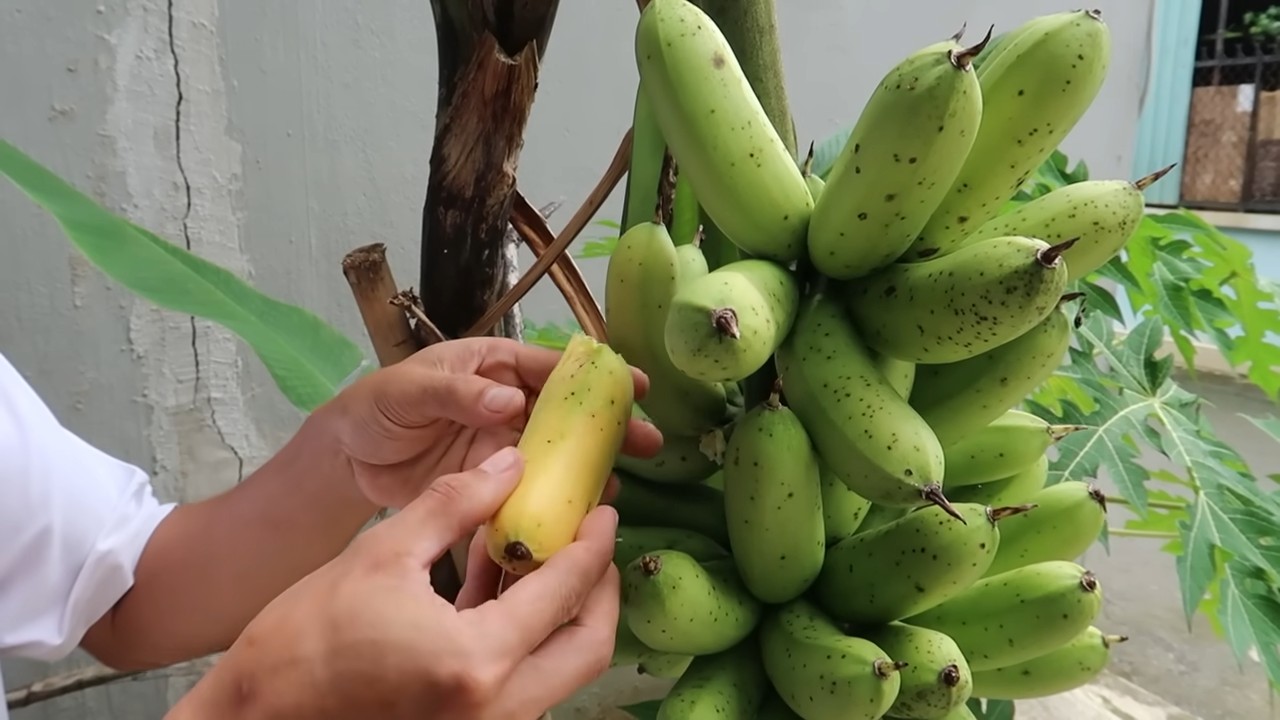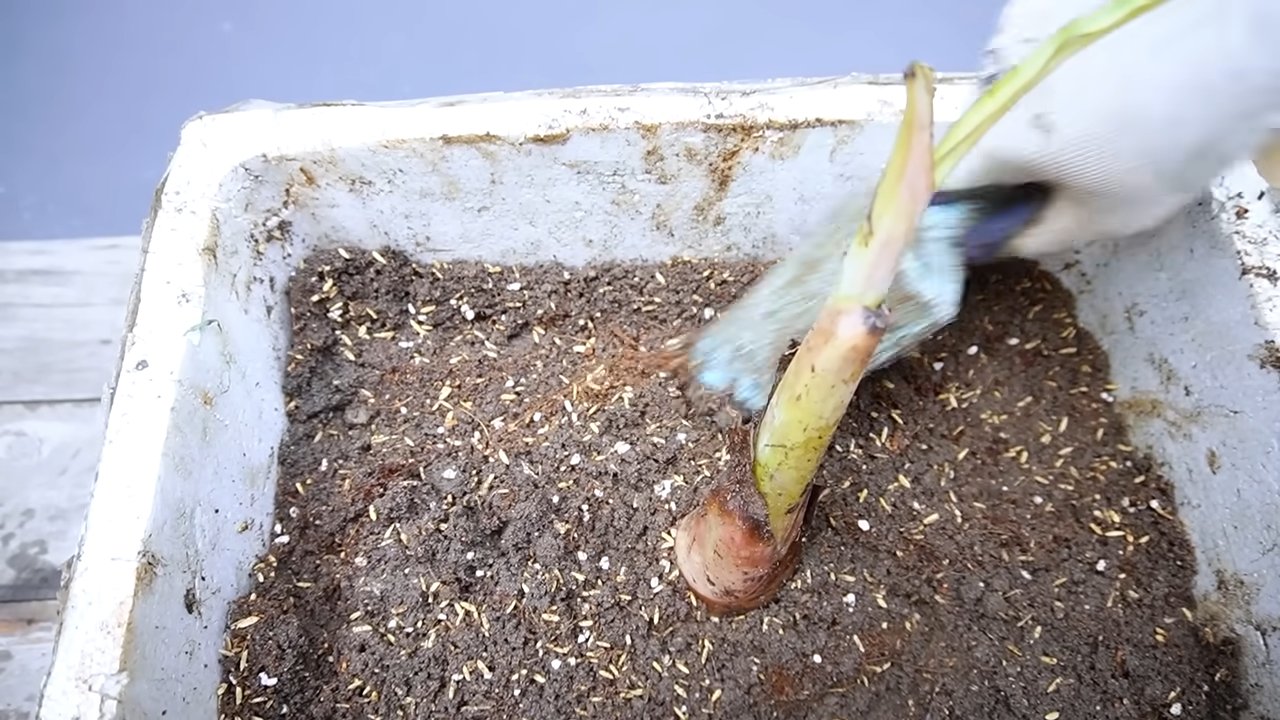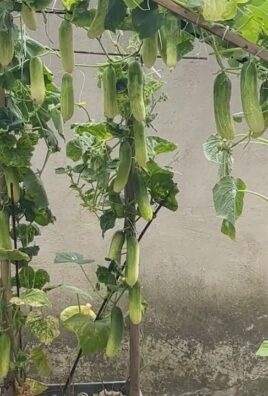Growing bananas at home might sound like a tropical dream reserved for exotic locales, but I’m here to tell you it’s more achievable than you think! Forget those pricey supermarket bananas – imagine plucking your own sun-ripened fruit right from your backyard. For centuries, bananas have been a staple food and a symbol of prosperity in many cultures, from Southeast Asia where they originated, to the vibrant Caribbean islands. Now, you can bring a touch of that tropical abundance to your own space.
But why bother with the effort? Well, besides the sheer satisfaction of nurturing your own food source, growing bananas at home offers a fantastic opportunity to connect with nature, learn about plant life cycles, and even impress your friends with your green thumb skills. Plus, homegrown bananas often taste sweeter and more flavorful than store-bought varieties. In this article, I’ll share some simple DIY tricks and hacks that will guide you through the process, even if you’re a complete beginner. Get ready to embark on a rewarding journey and transform your garden into a mini-banana plantation!

Growing Bananas at Home: A DIY Guide to Tropical Delights
Hey there, fellow plant enthusiasts! Ever dreamt of harvesting your own bananas right in your backyard? It might sound like a tropical fantasy, but with a little know-how and some patience, you can absolutely grow bananas at home, even if you don’t live in the tropics! I’m going to walk you through everything you need to know, from choosing the right variety to harvesting your delicious, homegrown fruit.
Choosing the Right Banana Variety
The first step to banana-growing success is selecting a variety that suits your climate and space. Not all bananas are created equal! Some are giants that need acres of land, while others are compact and perfect for containers.
* Dwarf Cavendish: This is a popular choice for home growers because it’s relatively small (reaching about 6-10 feet tall) and produces delicious, sweet bananas. It’s also fairly cold-tolerant compared to other varieties.
* Rajapuri: Another excellent dwarf variety, Rajapuri bananas are known for their creamy texture and slightly tangy flavor. They’re also quite wind-resistant, which is a bonus if you live in a windy area.
* Ice Cream (Blue Java): If you’re feeling adventurous, try growing Ice Cream bananas! These unique fruits have a bluish tint when unripe and a vanilla-like flavor when ripe. They’re a bit more cold-sensitive than Cavendish, so keep that in mind.
* Orinoco: This variety is known for its cold hardiness and can tolerate temperatures down to 20°F for short periods. The bananas are thick-skinned and have a slightly tangy flavor.
* Goldfinger: A relatively new variety, Goldfinger bananas are disease-resistant and produce sweet, slightly tangy fruit. They’re also relatively cold-tolerant.
Things to consider when choosing a variety:
* Climate: How cold does it get in your area? Choose a variety that can tolerate your winter temperatures.
* Space: How much space do you have available? Dwarf varieties are best for containers and small gardens.
* Taste: What kind of banana flavor do you prefer? Do you like sweet, tangy, or creamy bananas?
* Disease resistance: Some varieties are more resistant to diseases than others. This is especially important if you live in an area with a lot of banana diseases.
Preparing for Planting
Once you’ve chosen your banana variety, it’s time to prepare for planting. Bananas are heavy feeders, so you’ll need to create a rich, well-draining soil mix.
* Sunlight: Bananas need at least 6-8 hours of direct sunlight per day. Choose a location that gets plenty of sun.
* Soil: Bananas prefer well-draining soil that is rich in organic matter. A good soil mix would be equal parts potting soil, compost, and perlite or vermiculite.
* Container (if applicable): If you’re growing your banana in a container, choose a large pot with drainage holes. A 20-gallon pot is a good starting size.
* Fertilizer: Bananas are heavy feeders and need regular fertilization. Use a balanced fertilizer (e.g., 10-10-10) or a fertilizer specifically formulated for bananas.
Planting Your Banana Plant
Now for the fun part: planting your banana plant! Whether you’re planting in the ground or in a container, the process is pretty similar.
Step-by-Step Planting Instructions:
1. Dig the hole: Dig a hole that is twice as wide and as deep as the root ball of your banana plant.
2. Amend the soil: If you’re planting in the ground, amend the soil with compost and other organic matter.
3. Place the plant: Carefully remove the banana plant from its container and place it in the hole. Make sure the top of the root ball is level with the surrounding soil.
4. Backfill the hole: Fill the hole with soil, gently tamping it down around the plant.
5. Water thoroughly: Water the plant thoroughly after planting.
6. Mulch: Add a layer of mulch around the base of the plant to help retain moisture and suppress weeds.
Caring for Your Banana Plant
Once your banana plant is in the ground (or container), it’s time to provide it with the care it needs to thrive.
* Watering: Bananas need plenty of water, especially during the growing season. Water deeply whenever the top inch of soil feels dry.
* Fertilizing: Fertilize your banana plant every month during the growing season with a balanced fertilizer or a fertilizer specifically formulated for bananas.
* Pruning: Remove any dead or damaged leaves. You can also remove suckers (small plants that grow from the base of the main plant) to encourage the main plant to grow stronger. However, if you want to propagate new plants, you can leave some suckers.
* Pest and disease control: Keep an eye out for pests and diseases. Common banana pests include aphids, spider mites, and nematodes. Common banana diseases include Panama disease and black Sigatoka. Treat any problems promptly with appropriate pesticides or fungicides.
* Winter protection: If you live in an area with cold winters, you’ll need to protect your banana plant from frost. You can wrap the trunk with burlap or move the plant indoors if it’s in a container.
Encouraging Fruit Production
Getting your banana plant to actually produce fruit requires a bit of patience and attention to detail.
* Sunlight: Ensure your plant receives at least 6-8 hours of direct sunlight daily.
* Watering: Consistent watering is crucial, especially during flowering and fruit development.
* Fertilizing: Continue fertilizing regularly with a balanced fertilizer. You can also use a fertilizer higher in potassium to promote fruit production.
* Protection from wind: Strong winds can damage the leaves and fruit of banana plants. If you live in a windy area, consider planting your banana plant in a sheltered location or providing wind protection.
* Patience: It can take 9-15 months for a banana plant to produce fruit, so be patient!
Harvesting Your Bananas
The moment you’ve been waiting for! Harvesting your own homegrown bananas is incredibly rewarding.
* When to harvest: Bananas are ready to harvest when the fruits are plump and rounded, and the ridges on the sides of the bananas start to disappear. The color of the bananas will also change from green to yellow, depending on the variety.
* How to harvest: Cut the entire bunch of bananas from the plant with a sharp knife.
* Ripening: Hang the bunch of bananas in a cool, dry place to ripen. You can also place the bananas in a paper bag with an apple or banana to speed up the ripening process.
Dealing with Common Problems
Even with the best care, you might encounter some problems while growing bananas. Here are a few common issues and how to address them:
* Yellowing leaves: This can be caused by a variety of factors, including overwatering, underwatering, nutrient deficiencies, or pests. Check the soil moisture and fertilize if necessary. Inspect the plant for pests.
* Brown spots on leaves: This could be a sign of a fungal disease. Treat with a fungicide.
* Slow growth: This could be due to insufficient sunlight, poor soil, or lack of fertilizer. Make sure your plant is getting enough sunlight and fertilize regularly.
* No fruit production: This could be due to a variety of factors, including insufficient sunlight, lack of water, or lack of fertilizer. Make sure your plant is getting enough sunlight, water, and fertilizer. It can also take time for a young plant to mature enough to produce fruit.
Propagating New Banana Plants
Want to expand your banana plantation? You can easily propagate new plants from suckers.
1. Identify a sucker: Choose a sucker that is at least 1-2 feet tall.
2. Separate the sucker: Carefully dig around the base of the sucker and separate it from the main plant. Make sure to get as many roots as possible.
3. Plant the sucker: Plant the sucker in a pot or directly in the ground.
4. Water and care: Water the sucker regularly and fertilize it every month.
Enjoying Your Homegrown Bananas
Congratulations! You’ve successfully grown your own bananas at home. Now it’s time to enjoy the fruits of your labor. Eat them fresh, use them in smoothies, bake them into bread, or make banana pudding. The possibilities are endless!
Growing bananas at home is a rewarding experience that can bring a touch of the tropics to your backyard. With a little patience and care, you can enjoy delicious, homegrown bananas for years to come. Happy growing!

Conclusion
So, there you have it! Mastering the art of growing bananas at home is not just a whimsical dream; it’s an achievable reality with a little patience, the right knowledge, and a willingness to get your hands dirty. We’ve walked you through the essential steps, from selecting the perfect banana variety for your climate to nurturing your plant through its various growth stages. But why should you embark on this tropical adventure?
Firstly, the taste of a homegrown banana is simply unparalleled. Forget the bland, often underripe bananas you find in supermarkets. A banana ripened on the plant, kissed by the sun, and harvested at its peak is a flavor explosion you won’t soon forget. It’s sweeter, creamier, and bursting with that authentic banana essence that commercial varieties often lack.
Secondly, growing your own bananas is an incredibly rewarding experience. There’s something deeply satisfying about nurturing a plant from a small sucker to a fruit-bearing giant. It connects you to nature, teaches you about the rhythms of the seasons, and provides a sense of accomplishment that’s hard to replicate. Plus, you’ll have a constant supply of fresh, organic fruit right at your doorstep.
Thirdly, and perhaps most importantly, growing bananas at home is a sustainable choice. You’re reducing your carbon footprint by eliminating the need for long-distance transportation, supporting local biodiversity, and potentially reducing your reliance on commercially grown bananas, which can sometimes be associated with unsustainable farming practices.
But the journey doesn’t end here! Feel free to experiment with different banana varieties to find your personal favorite. Try adding organic fertilizers or compost to boost growth and fruit production. Consider companion planting with other beneficial plants to create a thriving ecosystem around your banana tree. You can even explore different methods of pest control to keep your plant healthy and productive.
And remember, growing bananas at home is a learning process. Don’t be discouraged if you encounter challenges along the way. Every mistake is an opportunity to learn and improve. The key is to be patient, observant, and adaptable.
We wholeheartedly encourage you to give this DIY trick a try. Imagine the joy of harvesting your own bananas, sharing them with friends and family, and knowing that you played a part in bringing this tropical delight to your own backyard.
So, grab your gardening gloves, choose your banana variety, and get ready to embark on a rewarding journey. We’re confident that you’ll be amazed by the results. And once you’ve harvested your first bunch of homegrown bananas, be sure to share your experience with us! We’d love to hear your stories, see your photos, and learn from your successes (and even your failures). Let’s create a community of banana-growing enthusiasts and spread the joy of this amazing fruit!
Frequently Asked Questions (FAQ)
What is the best climate for growing bananas at home?
Bananas thrive in warm, humid climates with consistent temperatures. Ideally, temperatures should range between 75°F and 95°F (24°C and 35°C) during the day and not drop below 60°F (15°C) at night. They need at least six hours of sunlight per day. While they are tropical plants, some cold-hardy varieties can tolerate brief periods of cooler temperatures, but prolonged exposure to frost will damage or kill the plant. If you live in a cooler climate, consider growing bananas in containers that can be moved indoors during the winter months.
Which banana variety is easiest to grow for beginners?
For beginners, the ‘Dwarf Cavendish’ is often recommended. It’s a relatively small plant, making it suitable for smaller gardens or containers. It’s also known for its good fruit production and relatively easy care. Other good options include ‘Rajapuri’ and ‘Ice Cream’ (also known as ‘Blue Java’), which are also relatively cold-hardy and produce delicious fruit. Research the specific needs of each variety to ensure it’s a good fit for your climate and growing conditions.
How often should I water my banana plant?
Banana plants are heavy drinkers and require consistent moisture, especially during the growing season. Water deeply and regularly, ensuring the soil remains consistently moist but not waterlogged. The frequency of watering will depend on your climate, soil type, and the size of your plant. Check the soil moisture regularly by sticking your finger a few inches into the soil. If it feels dry, it’s time to water. Reduce watering during the dormant season (winter) when the plant’s growth slows down.
What kind of fertilizer should I use for my banana plant?
Banana plants are heavy feeders and benefit from regular fertilization. Use a balanced fertilizer with a higher potassium content, as potassium is essential for fruit production. A fertilizer with an NPK ratio of 8-10-10 or similar is a good choice. Apply fertilizer every 2-3 months during the growing season, following the instructions on the fertilizer packaging. You can also supplement with organic fertilizers like compost, aged manure, or banana peel tea, which are rich in nutrients and beneficial for soil health.
How long does it take for a banana plant to produce fruit?
It typically takes 9-15 months for a banana plant to produce fruit after planting, depending on the variety, climate, and growing conditions. After the plant flowers, it takes another 3-6 months for the bananas to ripen. Be patient and provide your plant with the proper care, and you’ll be rewarded with a delicious harvest.
How do I protect my banana plant from pests and diseases?
Regularly inspect your banana plant for signs of pests or diseases. Common pests include aphids, spider mites, and banana weevils. Control pests with insecticidal soap, neem oil, or by introducing beneficial insects like ladybugs. Common diseases include Panama disease and black Sigatoka. Choose disease-resistant varieties and practice good sanitation to prevent these diseases. Ensure proper drainage to avoid root rot.
Can I grow bananas in a container?
Yes, you can grow bananas in containers, especially if you live in a cooler climate. Choose a large container (at least 20 gallons) with drainage holes. Use a well-draining potting mix and select a dwarf variety that is suitable for container growing. Provide regular watering and fertilization, and move the container indoors during the winter months to protect the plant from frost.
How do I harvest bananas?
Bananas are ready to harvest when they are plump, rounded, and the ridges on the fruit become less prominent. The color of the fruit will also change from green to yellow, depending on the variety. Cut the entire bunch from the plant using a sharp knife or machete. Hang the bunch in a cool, dry place to ripen. You can also separate individual bananas from the bunch and ripen them in a paper bag with an apple or banana peel to speed up the ripening process.
What do I do after harvesting the bananas?
After harvesting the bananas, the main stem of the banana plant will die back. Cut the stem down to the ground, leaving the sucker (new growth) to continue growing. The sucker will eventually mature and produce its own fruit. You can also remove some of the suckers to prevent overcrowding and promote better growth of the remaining sucker.
Is growing bananas at home worth the effort?
Absolutely! While it requires some effort and attention, growing bananas at home is a rewarding experience that provides you with fresh, delicious fruit, connects you to nature, and promotes sustainable living. The taste of a homegrown banana is simply unmatched, and the satisfaction of harvesting your own fruit is priceless. So, give it a try and experience the joy of growing your own bananas!




Leave a Comment